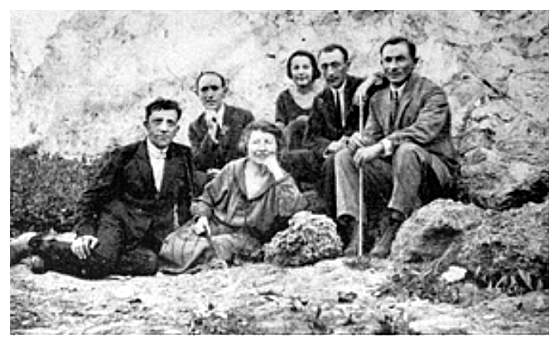 |
|
A group of Radomskers in 1923 in Neveh Tzedek
From the right: Sinai Fajngold, Sh. Waksman, Bela Fajngold, Regina Rozenbaum-Rozencwajg,
|
|
 |
|
A group of Radomskers in 1923 in Neveh Tzedek
From the right: Sinai Fajngold, Sh. Waksman, Bela Fajngold, Regina Rozenbaum-Rozencwajg,
|
Many of them played a great part in the construction of Tel Aviv and other cities.
Yitzhak Fajerman, Haim Grosman, Haim Goldberg, Hilel Zambek, Abraham-Hersh
Bugajski, Yitzhak Yudkewicz, the Aronowicz family and others built houses in
various cities and a number lost their capital during the later difficult economic
crises, after the first prosperous years. It should also be remembered that many
Radomskers helped other Radomsker workers both with work and with apartments
and loans (the initiative in this area of Yitzhak Fajerman and others must particularly
be remembered).
In spite of the economic crisis which reigned in the land and the cessation of immigration, more immigrants from Radomsk came to Eretz-Yisroel then, as parents to children (Haim Grosman and Karapka) or like Miss Lipszic to her brothers.
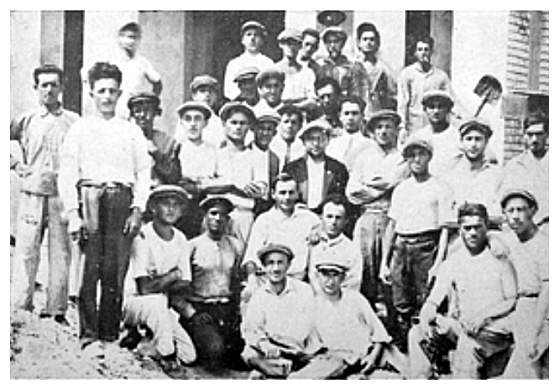 |
| A group of Radomsker construction workers in the 20's |
Halutzim (Pioneers) from Radomsk also came from time to time and after the events of
1929 the Halutz immigration was renewed a little through certificates that the Mandate regime
gave from time to time. (Yitzhak-Shmuel Moszkowicz, who had gone through
agricultural training in Kibbutz Klosewe arrived in 1930).
Shifra Witenberg, Tuvya Aronowicz, Moishe-Yitzhak Szitenberg (Shita) and A. Fiszelewicz came to the opening of the Maccabiah (a “Jewish Olympics”) (in 1932). Later N. Hofman as a returned resident. Yehudah Liberman came in 1939 with a “certificate”; later Yitzhak Lakhman and his brother Shmuel, both as “capitalists.” Leizer Mandel came in 1934 and a year later (in 1935) Haim Goldberg emigrated; after him Moishe-Yitzhak Szitenberg (for the second time) and many others.
In 1935, the Nonberg family, the parents of the future Israeli fighter and hero
“Yankele Saboteur” came. Fishel Karp, one of the first residents of
Holon, also came to the land and with his expertise and strong will overcame
many temptations and built an industrial enterprise that later greatly helped
the Haganah procure the needed gear for the struggle, behind the backs of the Mandate
regime. (Radomsker immigrants always found work in the industrial enterprises.)
Organization of Radomsker Immigrants in “Eretz-Yizroel”
There was close contact between the Radomskers in Haifa. These comrades, Haim Goldberg, Tuvya Rubinsztajn, Grosman, Minski, Lipszic, and others, were always ready to help the Radomskers who settled in Haifa and vicinity with whatever was possible. They maintained continuous contact with Tel Aviv and Jerusalem.
At that time, there was not yet any form of organization of Radomsker landsleit in Tel Aviv or Haifa. An attempt was made in Jerusalem in 1927 to legalize a society under the name Association of Former Radomsker Residents in Jerusalem with the English Mandate regime. In a letter of 25 November 1927 from the Jerusalem Provincial Governor addressed to the secretary of the society in Jerusalem, Hilel Liberman, it was said: “I have the honor to approve your application of 8 November 1927 and acknowledge that the society, the Association of Former Radomsker Residents, was registered in our Bureau with the number 508/3939 in accordance with the existing statues. You are to inform us of all changes that take place in the composition of the submitted managing committee.”
The founders of the organization were Yehoshua-Nukhem Rabinowicz, Noakh Wajnbtraub, Moishe Liberman, Mordekhai-Yakov Gold, Secretary – Hilel Liberman.
The number of Radomsker landsleit in Jerusalem was not large at that time
and the activities there were not intensive. In a letter of the 1stof
Elul 5699 (August 16, 1939), Hilel Liberman writes to landsleit
Yosef Kamelgarn in Tel Aviv: “To my great regret, I cannot undertake any
organizational or other activities on behalf of the Radomsker Association.
[Page 545]
My responsibilities do not permit me to do anything in this field or in others.
Therefore I am prepared to join in the association if others of our landsleit
who are not so busy will organize an association. It is worthwhile to look for
appropriate people who have the opportunity to dedicate time and energy for
this and are devoted to this work.”
In Tel Aviv and Haifa, where a larger number of Radomsker landsleit were concentrated, the time came to create an organization of all of the Radomsker landsleit in the land.
“We inform all Radomsker landsleit in Eretz-Yisroel that an organizing group in Tel Aviv at its last meeting decided to organize all of our landsleit in an association for the following tasks:
“We have elected a provisional committee that will organize the work until the coming general meeting. We turn to all of our landsleit and call on you to register as members of the association and obligate yourself to pay monthly membership dues, or according to your ability. We hope that all will respond to our message and will help to establish our association.
“You are asked to return promptly to the registration bureau at the address: Zelvulun St. 31, Tel Aviv at 7-8 in the evening.”
This appeal was signed by Haim Grosman, Shlomoh Waksman, Shmuel Lakhman, Yehoshua Kalka, Yosef Kamelgarn, Dovid Krojze, Shlomoh Krakowski, Moishe-Yitzhak Szitenberg.
The quoted appeal points out the will of the Radomsker landsleit in Eretz-Yisroel
to live close together and help each other in every respect. It was literally
a prophetic premonition to organize in light of the later tragedy for our
people in order to be ready for the activities for the Radomsker brothers in
the Second World War and for the survivors of the Holocaust.
Help for the Refugees and Survivors
The Second World War broke out and immediately the dark news came of Polish Jewry in general and of our brothers in Radomsk in particular. Normal human understanding absolutely could not absorb the tragic events, the dark suffering of the Jews, the murderous actions of the German-Hitlerist gangs. From time to time, the news broke through. However, the wider world did not believe it or did not want to believe it.
News began to arrive from Radomskers who were successful in saving themselves in Russia. The Radomskers in Israel immediately organized aid activities to send food packages and clothing to Russia for their landsleit (virtually to every address of a Radomsker that could be found). The activity was coordinated with the landsleit in America and many of the Radomskers in the Soviet Union during the most difficult war years were delighted with this help
In the later war years the dreadful news was already clear. The Radomsker landsleit, M. Zandberg, came from Egypt and brought details about the mass death. Later Yakov Kurtz, who had visited Piotrkow before the war and became stuck there, wrested himself from there and came back to the land during the war years. He told about the destruction of Polish Jewry, particularly about Piotrkow and Radomsk; he also later published a book about this under the title Sefer Eides (Book of Witness).
Together with the enormous grief and deep pain of every Radomsker, the great responsibility that lay on the small Radomsker community in Eretz-Yisroel in such a moment became very clear. Even while the Jewish population in Eretz-Yisroel found itself in a difficult political condition, that did not stop them from proceeding to establish an organizational framework for the aid activities that had to be undertaken for all those who would save themselves from the Hitlerist gehinem.
In 1944 a provisional managing committee of the Irgun Yotzei Radomsko (Organization of Radomskers) in Israel was created in Tel Aviv with the following members: Shlomoh Waksman (President), M. Khatumi, (Secretary), Yehoshua Kalka, Dovid Margolewski, Leah Birnbaum-Telman, Dovid Krojze and Moishe Szitenberg. An aide fund for the Radomsker survivors in Europe was immediately created and it organized a planning group of Radomskers in Haifa. The group of Radomskers in Haifa, simultaneously with the landsleit in Tel Aviv, made every effort to organize help for the brothers from Radomsk once the extermination in the European gehinem ceased.
At the end of 1945 several of the surviving Radomskers began to arrive in the land, such as Zev Sabatowski, Yitzhak Kuppersztok and others, who described the extermination of our fathers and mothers, brothers and sisters.
The English Mandate regime in the country created all kinds of difficulties and
impeded the remnant of Polish Jewry from coming to Eretz-Yisroel; they
were sent to Cyprus, again in dark camps. In various ways, chiefly through our
landsleit Dovid Klei, who was delegated by the Histadrut ha-Kelalit
(Jewish Labor Federation) to Cyprus, the Irgun was successful in establishing
contact with the Radomsker refugees there.
[Page 546]
The aid action that was then organized by the Radomskers in Eretz-Yisroel was
vast. Food and clothing was sent both to the camps in Cyprus and to Germany
and other nations where Radomskers were found. Medical aid was
also organized for the victims, in cooperation with our brothers in America.
The activity at that time was feverish. Storage for produce and clothing was
found with Comrade Shlomoh Waksman; all comrades were drawn into the work. A
whole line of Radomsker women worked very intensively at collecting, packing
and sending the aid packages all over to places from which news had succeeded
in arriving from a surviving Radomsker Jew.
The Irgun was very active at that time in attracting still more landsleit to the work. The Irgun then turned to the Radomskers who were found in the Eretz-Yisroel Brigade to take an interest everywhere in Europe, where there was still the possibility of finding surviving landsleit and to help them. Our surviving brothers and sisters were found in the D.P. camps in Germany, Austria, Italy, Cyprus, France and Belgium and also in other nations. The Irgun then turned to Poland, to the Central Jewish Institutions for information about our landsleit. As a result of this, on the 20th of July 1945, a telegraphic message was received by Yehuda Liberman and Haim Goldberg from Professor Yosef Sak in Warsaw with a list of 127 Radomsker Jews who remained alive and temporarily found themselves in Radomsk. The Irgun made an attempt to contact all surviving landsleit and thus, on the 27th of November 1945, a list of over 300 surviving Radomsker Jews was published in the newspaper Lekarov vLerkhok (To Those Near and Far).
Shlomoh Rabinowicz, the son of Yehezkel Rabinowicz visited Radomsk in 1946 and
in a letter from there described the sorrowful appearance of the 70 Jews that
he found, all almost half dead, broken spiritually and physically. The Shul
Street made a terrible impression on him and especially the mass grave in the
cemetery; the impression was so dreadful that he literally ran from the city.
Before the Independence of Israel
At that time Eretz-Yisroel became involved in a difficult struggle with the
English mandate regime and with the Arab terrorists. The Radomsker Irgun
in Eretz-Yisroel took a very active part in the Eretz-Yisroel Brigade,
in the Haganah, Irgun, the Stern Gang, and later in the Israeli
Defense Forces. Their contribution to the war of liberation of the Land of Israel
was very significant; together with other dear fighters who fell for the independence
of Israel, our Radomsker brothers rest in military cemeteries over the entire land.
There is a special section in this part of the book dedicated to their memory.
Honor their memory!
Material and Spiritual Absorption
With the rise of the Land of Israel, the gates opened wide for all of those who through a miracle survived the Holocaust and extermination. The Radomsker Irgun mobilized to solve the various problems of their immigrant landsleit. They were in need of a warm brotherly hand, a warm word, as well as constructive help in settling in the country.
A large group of Radomskers in Tel Aviv and Haifa immediately collected a large sum of money for an Interest-Free Loan Fund to assist the immigrants who needed to begin a new life, both those who survived murderous German Hitlerism and those who returned from Russia.
Scores of letters from that time give evidence of the massive aid that was
given when the landsleit arrived in the country. The social workers from
Irgun who had good connections in the land, such as Haim Goldberg and others in
Haifa, Sh. Waksman and the Kalka brothers, Wincentowski and others in Tel Aviv,
made an effort through various interventions to facilitate the absorption of
their landsleit.
Interest-Free Loan Funds in Tel Aviv and Haifa
The sum of money in the Interest-Free Loan Funds both in Haifa and Tel Aviv proved to be insufficient. In 1951 the then president of the Radomsker Aid Society in America, Yehezkel Rudnicki, visited Israel and, immediately after his return to America provided a large sum that enabled almost every Radomsker immigrant to receive a loan.
Later, the Interest-Free Loan Fund was named after Shlomoh Epsztajn of blessed memory, the deceased landsleit in America who was devoted with life and limb to helping the needy landsleit in Israel.
In 1953-54 when the new landsleit were already somewhat settled and loans were not requested very often, the activity of the Interest-Free Loan Fund was diminished. In 1955 the Interest-Free Loan Fund was reorganized and a new managing committee was elected with the following members: Yosef Lakhman, Dov Waldfogel, Abraham Waldfogel and Dovid Krojze.
At the take over of the Interest-Free Loan Fund by the new managing committee, the balance was as follows:
| Israeli Pounds | |
| In cash | 146.70 |
| Deposits in the bank | 1,697.00 |
| Loans | 1,252.00 |
| Total | *3,095.71 |
(* Translator's Note: This total is as it appears in the book.)
Our Interest-Free Loan Fund in Tel Aviv communicated with the central
Interest-Free Loan Fund of Histadrut (Mish'an), which doubled
the sum for the loans and permitted the distribution of loans
for Radomskers not only in the city, but all over the entire country (The same
was done by the Interest-Free Loan Fund in Haifa).
There were cases when the requests were larger than the possibilities; then
several members gave personal commitments to be able to assist landsleit
with constructive aid. During the years 1956-1960, 170 loans were given out in
the sum of 35,000 Israeli Pounds (just in Tel Aviv).
[Page 547]
A Housing Development for New Radomsker Immigrants
The constructive help of the Interest-Free Loan Fund was depleted by the absorption problems of the immigrants in general and the Radomskers in particular. The refugees streamed in en masse; the Jewish Agency and the government had to worry about a temporary roof over their heads. There arose then the tent camps for the immigrants, in which were found Radomsker landsleit. A plan then sprang up from the Society in New York to build several dwellings for the Radomsker refugees. After long negotiations, it was decided to join with the Shikun Construction Company of Histadrut Haovdim Hakelalit (General Federation of Laborers) in building two houses in Holon, as a housing development for Radomsker landsleit in tent camps.
The landsleit in America really made great financial efforts for this purpose and the landsleit in Israel (both in Tel Aviv and Haifa) did a great deal to implement the idea. At last the Sunday of the 11th of November 1951 was set as a deadline to lay the cornerstone of the two houses as Shikun Yotzei Radomsk (Radomsker Apartments).
The enthusiasm of the comrades in Israel was very great. The managing committee of Irgun published a solemn appeal in which it was said among other things:
“Dear Comrades! Sunday, the 11th of November 1951 at 3 o'clock in the afternoon, our yom-tov (holiday) will be marked. On this day the cornerstone will solemnly be laid for the houses of Shikun Yotzei Radomsk and representatives of various national institutions will be represented, as well as a representative of our brothers in America, Comrade B. Kugel and his wife.”
In the presence of the mayor of Holon Dr. D. Kugel, Prof. A. Reis, chairman of Histadrut Olei Polin (Union of Polish Immigrants), representatives of the Jewish Agency, the Shikun Company and many other guests and with the participation of several hundred landsleit, Haim Goldberg, of blessed memory, opened the celebration.
Haim Goldberg presented a survey of the general activities of Irgun and its connections with Radomsker landsleit all over the world. He described Jewish life and mutual aid in old time Radomsk, when one helped the other in times of need and times of trouble. He cited the great calamity of destruction and mass death that had obliterated forever the city and its Jewish population. He also recalled our dear Radomsker young men who fell in the War of Independence of the Land of Israel and the Radomsker fighters and rebels, who resisted the German barbarianism, defended Jewish honor, took revenge for spilled innocent Jewish blood.
Haim Goldberg ended his speech* with the following words:
“The two buildings, for which we lay the ground stone will facilitate the absorption of our rescued brothers newly arrived in Israel. Let this achievement, which we here start to realize, serve as an expression of solidarity and brotherliness that reigns among our landsleit who are spread over the world – two dear qualities that characterized our annihilated Radomsk Kehile that lives in our hearts.”
After a series of greetings from the representatives of institutions that
participated in the ceremony, the secretary M. Khatumi read aloud the solemn
scroll written for the purpose. The general mood was very elevated and the
celebration left a great impression on all present. It was underlined that the
Radomskers in Israel and America were the first who were not stopped by any
difficulties in creating a roof over the heads of the hard-suffering Radomsker
brothers and sisters who after such tragic experiences lived to come to
Eretz-Yisroel and to build here anew their home.
Dedication in Holon and the Unveiling of a Headstone in “Martef-Hashoah”
(the Chamber of the Holocaust) on Mt. Zion in Jerusalem
The two houses were completed in a few months. On 6.7.52 (July 6, 1952) a dedication ceremony took place in the presence of a great number of landsleit from Israel and guests Hershel Epsztajn and Eddy Oifman and their wives from America.
The houses consisted of 8 apartments with two rooms with a kitchen and large hall. In as much as the number of Radomskers who needed apartments was very great, the Irgun assigned 3 single young men to the 3 childless families that occupied the apartments. Thus 8 families and 3 single young men were settled. Alas, the apartments created bad blood and resentment, while the plan for building more houses and bringing more tenants there unfortunately was not realized. It was learned moreover that the activities of Irgun almost became paralyzed, and the landsleit in America, who really made the greatest financial efforts in building the houses, received various unpleasant messages.
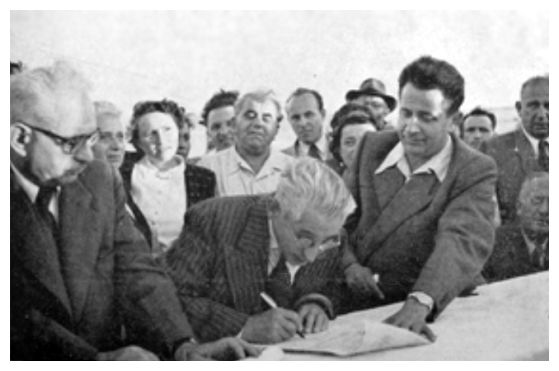 |
| B. Kugel, the landsleit from America, signs the solemn scroll |
The community workers among the Radomsker landsleit in Tel Aviv and Haifa
in addition to all of this concentrated their work in the Interest-Free Loan Fund, with
the housing developments and with the organization of the yearly memorial service
for the martyrs from Radomsk who perished. The Irgun had a headstone in
memory of the martyrs in the form of a double marble tablet placed in the wall in
the Chamber of the Holocaust on Mt. Zion in Jerusalem. The solemn unveiling took
place on the 11.10.55 (October 11, 1955) with a large number of landsleit present.
Yearly memorials are arranged in Jerusalem from time to time near the headstone
on Mt. Zion.
The Publication of the Yizkor Book
The difficult work of the Radomsker community workers in Israel during the 25 years since 1939 did not weaken the desire of individual members to think about and to plan the undertaking of the publication of a Yizkor Book in memory of the Radomsk Kehile. Member Haim Goldberg, of blessed memory, in Haifa, aware of the extreme difficulty of publishing such a book, had begun to collect materials (documents, photographs and the like) years back and convinced other members that they should assist in this work.
In the beginning, the landsleit in America showed little interest. However Comrades Rudnicki and Pinye Kalka, who became familiar with the assembled material during a visit, promised to make all efforts, mainly financial, so that the book could happen. Alas, shortly after his visit to Israel, Comrade P. Kalka died suddenly and the American landsleit again became passive (the failure of the houses in Holon also had a negative effect). In the middle of it all, Sol Grinberg, one of the prominent Jewish personalities in America, a devoted Radomsker landsleit and one of the most distinguished donors and community workers, died there. In his will, he left a large sum for a memorial house in Tel Aviv to the memory of the fallen, murdered and annihilated Radomsk Jews. There was to be a room name after the deceased donor in the house in which would be collected all materials about his social and philanthropic activities. The proposal provoked strong opposition by the active Yizkor Book workers in Israel, who requested that the money be used first of all for the book and later a meeting hall should be bought for the Irgun. Their request remained a minority position and a meeting hall was bought on Hulda Street 9 in Tel Aviv, in accord with the will.
In its own meeting hall, gatherings and memorial services of Irgun are arranged annually; receptions are held there for visiting landsleit who come to Israel; there the Interest-Free Loan Fund and other Landsmanschaft undertakings are carried out. The meeting hall is an important achievement, although in its time the bad financial situation affected the activity on the book, which stopped almost completely.
Then the community worker Yehuda Liberman took his place as the head of Irgun (in 1958). In his report of 1961 to the general membership of Irgun, we read among other things: “As I have become acquainted with the situation in Irgun, I have decided that until the housing development is regulated, no normal activity will be possible for Irgun. We succeeded together with other council members in reaching an understanding with almost all of the residents and now they fulfill their financial obligations (with the exception of one of them). After solving the housing development problem, the most difficult and most important question for Irgun in general and for every landsleit in particular was the publication of the Yizkor Book. It is clear that as long as only 2 or 3 members are employed with this question that it could not be carried to a positive end. All landsleit must take part in the creation of a matzeyve (headstone) for the city in which they were born and raised. True, it is not easy to raise the money from the landsleit members, who are spread over the country, but have we done everything? Up to now 150 of the 350 landsleit have contributed and we are striving to prepare the book for printing. We have already made an agreement with the printer, Ahudut, about publishing the book.”
Year after year passed and the difficulties in realizing the publication of the book grew without end. Only a small number of members helped with the work and, in time, the number became smaller. In addition the financial difficulties were great. Only after the visit of Comrade Yehezkel Pacanowski, of blessed memory, the Secretary of the New York Society of Radomsker landsleit, was there a small increase in the success of fundraising from the American brothers. They sent their archive of over 60 years of activities of the Radomsker Landsmanschaft Society in America to Israel.
Then the work on the book took on new energy. Yehuda Liberman saw the publication of the book as the main goal of his activism in Irgun and, thanks to this the goal was achieved with the aid of his close co-workers.
The other work of Irgun was abandoned. At a general meeting, which took place on 2.7.62 (July 2, 1962), the following members were elected to the managing committee: Yehuda Liberman (Chair.), Moishe Hartman (Sec.), Yehoshua Kalka (Treas.), Yehuda Waksman (I-F Loan Fund), Haim Goldberg, Abraham Waldfogel, Moishe Szitenberg, Mordekhai Khatumi, Yakov Alpert, Pola Gaslowska-Fajerman, Zev Sabatowski.
Over time, changes took place in our status in Israel. The once new immigrants were rooted in the land, like everyone else. Thus, pressure on the Interest-Free Loan Fund lessened significantly. In general, the activity of Irgun weakened – the years have their effect, many active people are physically broken and ill. Immigrants from Radomsk no longer came. The older generation becomes fewer.
Now when the Yizkor Book is finished, our two community workers must be
recorded here – Haim Goldberg, of blessed memory, and Yehuda Liberman,
long may he live, who had the greatest responsibility for the realization of this
undertaking.
[Page 549]
Haim Goldberg was the first one to understand and express the great importance
of such a book and the idea spread among the members of Irgun. He dedicated
much time and effort to work on the book, collected material (documents, photographs
and so on) and influenced other landsleit to help him. Even in his last weeks,
despite his difficult illness, he did not stop thinking about the book and made efforts
so that the book would be rich in its contents and beautiful in its form.
Haim Goldberg found a devoted partner in this effort in the Chairman of Irgun
Yotzei Radomsko, Yehuda Liberman, who particularly in the last years (from 1959) dedicated all
of his strength to raising the necessary money, collecting additional material
and caring for all matters connected with composing and publishing this book.
The history of Irgun Yotzei Radomsko b'Yisroel is a web of devotion, brotherly feelings and mutual assistance that were the essential mark of our city Radomsk. When our city met its frightening misfortune, the noble quality of our parents was awoken in the hearts of the Radomsker sons and daughters in Israel. Here it was again revealed in its full luster, the sincerity and self-sacrifice, together with practical activities, in helping out the suffering landsleit-brothers. Thanks to these qualities of the Irgun Yotzei Radomsko, the important and fruitful activity of concluding the publication of this book was carried out.
Let these lines be a modest expression of a deeper examination of the Radomsker immigrants of all generations and of all the aliyahs and serve as a witness to their courage and devotion, perseverance and creativity that have struck deep roots in the Land of Israel.
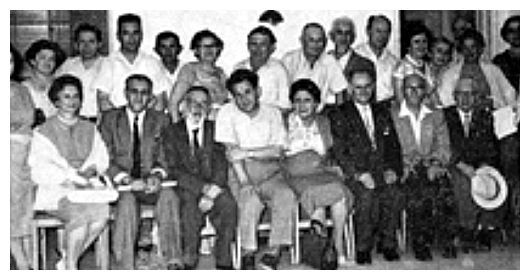 |
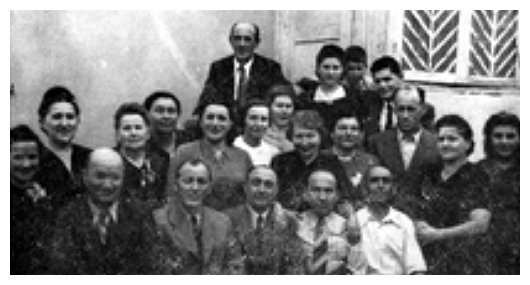 |
|
| Y. Pacanowski from New York among landsleit in Haifa (1961) | From the Third Aliyah | |
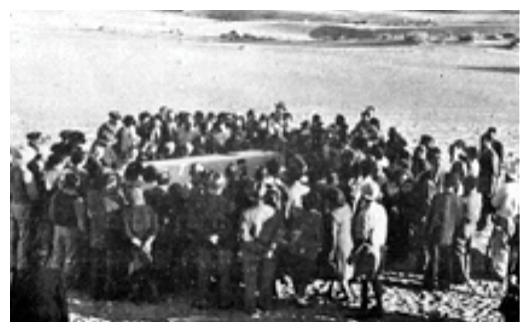 |
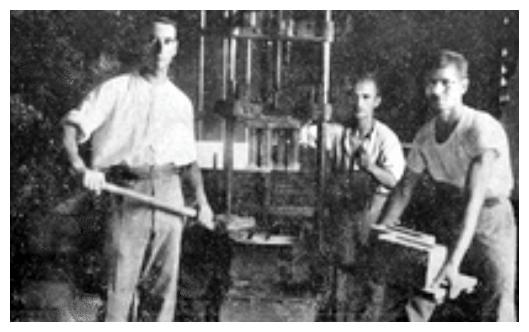 |
|
| …During the laying of the cornerstone for the housing development in Holon | …At the hard work of brick-making |
|
JewishGen, Inc. makes no representations regarding the accuracy of
the translation. The reader may wish to refer to the original material
for verification.
JewishGen is not responsible for inaccuracies or omissions in the original work and cannot rewrite or edit the text to correct inaccuracies and/or omissions.
Our mission is to produce a translation of the original work and we cannot verify the accuracy of statements or alter facts cited.
 Radomsko, Poland
Radomsko, Poland
 Yizkor Book Project
Yizkor Book Project
 JewishGen Home Page
JewishGen Home Page
Copyright © 1999-2024 by JewishGen, Inc.
Updated 05 Dec 2021 by OR